Recent Updates
09/07/2025 12:00 PM
Mini Aceman long-term test: charming, but massively flawed
09/07/2025 12:00 AM
Police and cyber experts brought in as JLR remains crippled by hack
09/06/2025 12:00 PM
A Mini adventure: exploring Yorkshire in a John Cooper Works
09/06/2025 12:00 PM
Identikit car design has reached epidemic levels
09/06/2025 12:00 PM
Every model discounted by the Electric Car Grant
09/06/2025 12:00 AM
Europeans major on tech and design at Munich to slow China’s march
09/06/2025 12:00 AM
Changan: How major Chinese brand plans to conquer UK market
09/06/2025 12:00 AM
Xpeng G9
09/05/2025 12:00 PM
New BMW iX3 revealed as UK's longest-range EV
09/05/2025 12:00 PM
BMW shows new i3 for the first time – and confirms 2026 launch
EV, Hybrid, Hydrogen, Solar & more 21st century mobility!
 A small electric SUV should be a breeze in 2025. Did Mini pull it off?
A small electric SUV should be a breeze in 2025. Did Mini pull it off?
Some of you might recognise YE74 NKC. This Mini Aceman graced this publication some time ago, where I delivered a two-and-a-half-star verdict on it.
It’s important at this point to note that it underachieved in this specific form: the small-battery one. The big-battery achieved three and a half stars.
I’m hoping that living with this car might prompt a thorough reappraisal and prove the smaller battery isn’t so much of an impediment to daily life.
Let’s make some introductions. The Aceman is Mini’s new electric-only baby crossover – a rival to the Volvo EX30 and Ford Puma Gen-E and ostensibly a tall and chunky Mini Cooper hatchback.
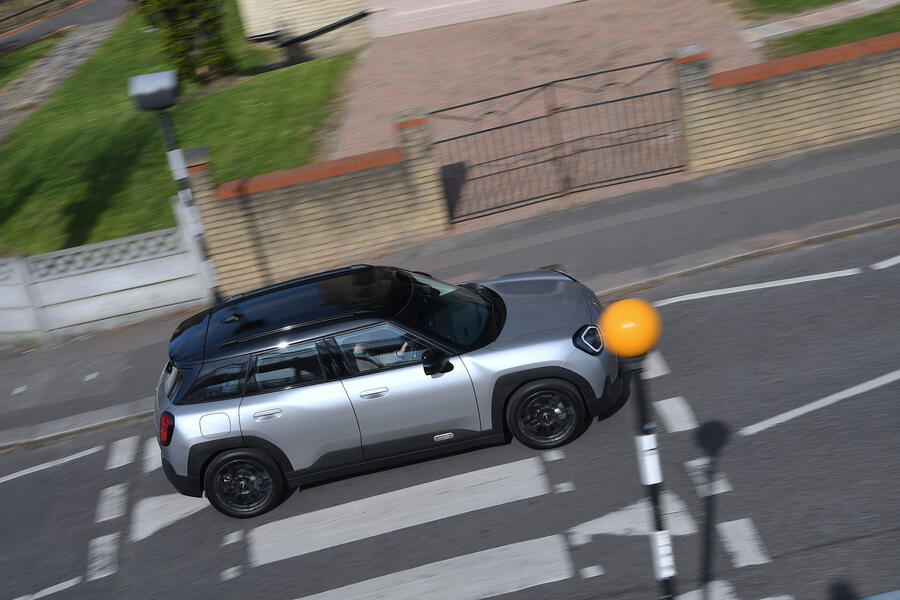
The E version has a diddy usable battery capacity of 38.5kWh, which the WLTP lab boffins reckon is good for 190 miles of range.
When I saw the spec sheet, I didn’t think much of the silver body and grey wheels combination, but it really works in the metal. The paint’s hues range from blue to grey, depending on how the light catches it and the alloys are a dark, slightly metallic grey.
Mini pitches this Chinese-made crossover as a halfway house between the Cooper and the Countryman SUV. A deft move, really, as the former is one of the smallest cars on the market today, while the latter has grown to the size of a Nissan Qashqai.
Step inside and things are good. The circular infotainment touchscreen may be massive, but what really struck me first is the seating position. It’s upright and the driver gets an armrest, a bit like the captain’s chair you would find in a Range Rover.
To me, it’s perfect for this little SUV aimed at city folk who want 4x4-aping looks and a domineering view out while keeping things small enough to not make parking a nightmare. I haven’t managed to create a ‘profile’ on the infotainment system yet.
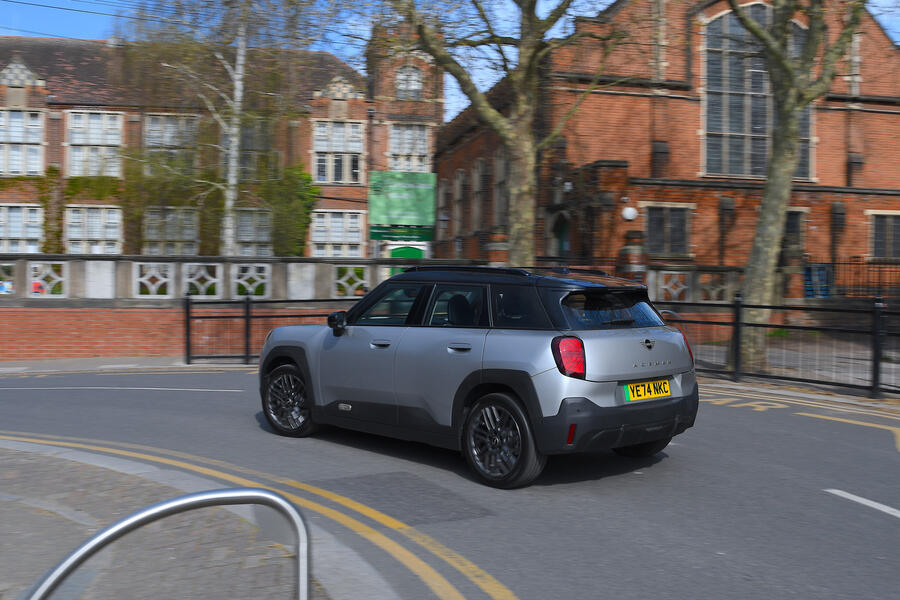
The first few times I drove the car, I was in a bit of a rush and didn’t have time. But before embarking on a longer trip recently, I sat down and came up short, apparently due to ‘no server connection’. I probably wasted about 20 minutes.
I will try again and let you know if I succeed. Not having a profile may not sound all that problematic, but I assure you it is, for two reasons.
First, unless you make a profile, the system doesn’t remember any of your settings, including your phone. So every time I’ve driven the car, I’ve had to pair my phone via Bluetooth. I prefer to use Apple CarPlay to any car’s in-built software, simply because Apple spends more money developing software than car makers do whole cars.
When I use it here, though, it appears on the circular screen in a small square box, which looks crap and is just not as big as I’d like. Bit of a fail there. Oh and get this: the Mini doesn’t have wired Apple CarPlay, so yes, I do need to reconnect my sodding phone via Bluetooth each and every time.
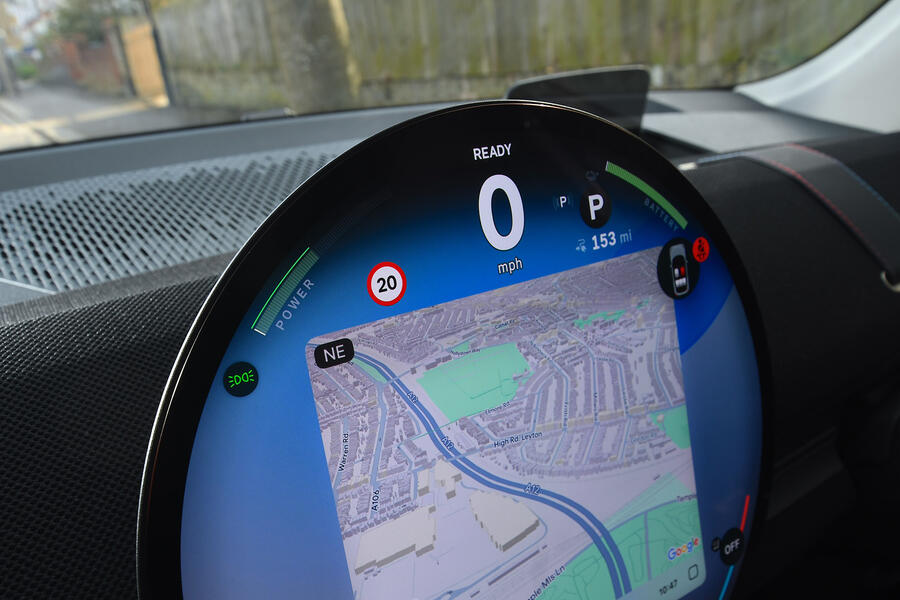
Second, I’m in my thirties and manage a website for a living, so if I can’t get the thing set up, how are people like my mum supposed to do it?Â
One more gripe. My local public chargers provide 22kW of AC, but the Aceman E is limited to 11kW of AC, making the whole process take longer – which is a shame, because one of the benefits of having a relatively small battery should be that it’s quick to charge. It can handle 70kW of DC, but you only really find those faster chargers at service stations.
Pros? In a world where new cars are very expensive, £31,445 for a fashionable electric Mini crossover feels reasonable (especially compared with the £34,350 price it turns out Mini erroneously quoted us when we first tested it).
It basically has the same interior as all the other Minis, which is pared back but feels really well put together and has a nice blend of materials. Mini loves an options pack, and my car is fitted with one (Level 1 goodies listed below). So far, I’d say that the head-up display seems essential; the infotainment screen is large and clear, but it makes sense having your MPH in line with the steering wheel.
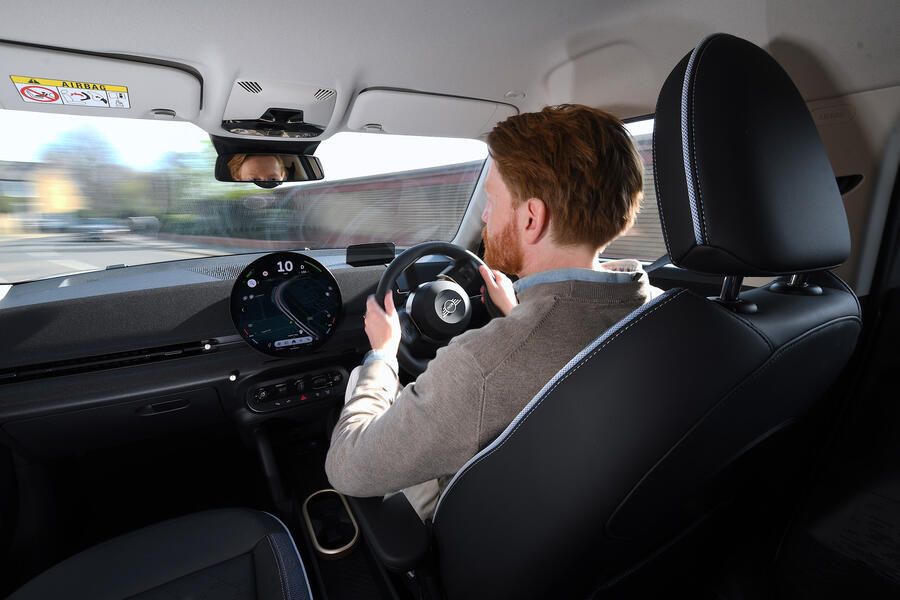
I’ll report later on just how much I use the stuff in it. I’ll also write in detail about the Aceman’s dynamics, because it has some quirks, but in short it feels very Mini, in that it’s pokey and tightly sprung.
The reason we have this Aceman here is because of the conundrum of its core numbers. Its 190-mile range from a 38.5kWh battery may look a bit 2020, but I’m wondering if maybe Mini doesn’t need to move the game on in terms of hardware.
Maybe it just needs to do the ‘cool-looking and reasonably priced’ thing? And maybe, just maybe, Mini is banking on things changing.
Having an EV with 150-ish miles of real-world range might have been a pain a few years ago, but is it possible that Britain’s charging infrastructure has improved to the point where buying a car with small, economical and cheap batteries is viable in 2025? After all, EVs with small batteries weigh less and should do more miles per kWh than their larger battery cousins. Let’s find out.
Update 2
When I wrote the ‘hello’ report for my Mini Aceman recently, I posited some questions to consider in the time it will be with me, which is standard fare. But being able to answer one of those questions so quickly – or at least answer it with a small asterisk – was quite unexpected.
I made a suggestion that there might someday be a point at which small battery EVs would make more sense than they do today – you know, once we get efficiency up and the charging infrastructure more reliable.
And, believe it or not, a recent experience with said infrastructure was so good that I’m already coming round to the idea of owning a small-battery EV.
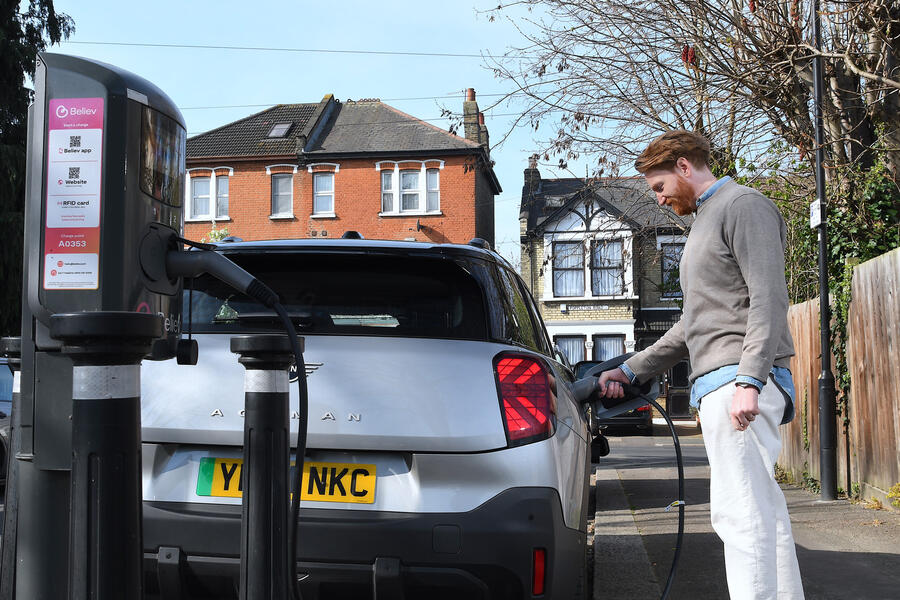
I was heading to Milton Keynes-ish to see my brother, go to a gig and then head home again – roughly a 160-mile round trip and theoretically achievable on a single charge. But I know better. And he doesn’t have a charger.
So filling up with watts en route was on the menu. I’m working at becoming less anally retentive, so decided not to triangulate air temperature, wind speed and number of chargers per capita in order to find somewhere to replenish the battery: I simply selected a motorway service station that would be most convenient for the journey.
In this case, it was Newport Pagnell services on the M1, where I was greeted by a nearly empty set (save for a Maxus eDeliver 3 van) of 15 180kW chargers from Applegreen Electric, a company I hadn’t heard of before.Â
Service stations up and down the country have delivered both good experiences and bad ones, but this was the easiest and quickest set-up I have yet encountered.
For a start, the charger actually worked, so no time was wasted finding another one. And there was no sign-up nonsense – nothing to fill in at all, in fact.

Tap bank card, take charger out, stick in car, go and use the lavs, wait until it had charged enough, tap card again, take charger out of car, leave. While UK law now states that all new fast chargers need to accept contactless card payment, there are still so many older ones about that this remains something to celebrate.
Anyway, the car did annoy me slightly during this process. The chargers may offer 180kW, but this Aceman can pull in only 70kW. Looking at the infographic supplied by Applegreen, it peaked at only 62.6kW and averaged 41.5kW.Â
There are too many variables to list here (I also charged it beyond 80%) to get truly annoyed, but still… It is semi-annoying that my local chargers provide 22kW but the Aceman can accept only 11kW, and motorway service stations are now providing fairly seamless 180kW solutions, yet the Mini can only charge at 70kW. At best.
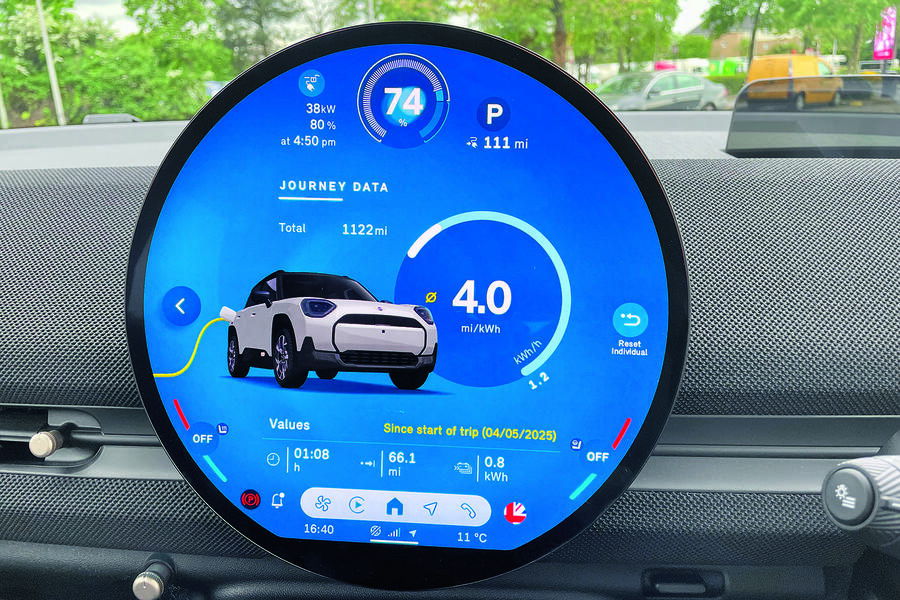
Anyway, this jaunt also taught me a few more things about the car. It averaged 4.0mpkWh, which really isn’t shabby at all for motorway work. This was probably helped somewhat by a 50mph limit on the M25, but I wasn’t on an efficiency run and had the heating set as normal, and I otherwise drove at speeds I would ordinarily do.
The ride at a motorway cruise is fantastic. Really top notch. And the old-fashioned ‘unintelligent’ cruise control is so handy: two buttons to set up and one switch to change speed. And it will let you get as close as you like to the car in front!
It’s such a shame this particular Aceman seems so at odds with what I think small-battery EVs should be good at – which is driving around town, where the ride is still rotten and I wince at potholes, speed bumps and drain covers.
Update 3
You never thought you would read the terms ‘Mini’, ‘SUV’, ‘electric’ and ‘good value’ in the same sentence, but here we are.
The realisation that my Mini might actually be a bit of a bargain came after spending some time in our new Citroën ë-C3. It is, after all, a very close rival to the Aceman E.
Okay, so BMW-era Mini has been all about sporty handling and puppyish fun while Stellantis-era Citroën has focused on comfort and simplicity, but both of these cars are small electric SUVs with sub-200-mile ranges aimed at young people: jacked-up versions of established superminis with strong heritage and legions of fans.
Reassuringly, despite those similarities, the ë-C3 and Aceman are very different cars. There are people online who decry that “all electrical cars are the same†(they like to use ‘electrical’ as an unfunny faux naivety), but they are actually pretty different to drive.
The Aceman at times feels at odds with itself, its firm and unforgiving suspension slapping its city car remit in the face. Meanwhile, the ë-C3 feels much more fit for purpose when confined to 30mph limits, largely due to its soft suspension.
Out of town, the Aceman is a better companion. It’s some 80bhp up and therefore 3.0sec quicker from 0-62mph. At times, the difference between the pair feels even stronger than that, I suspect because the ë-C3 is actually a full second slower than its advertised time, according to our stopwatch.
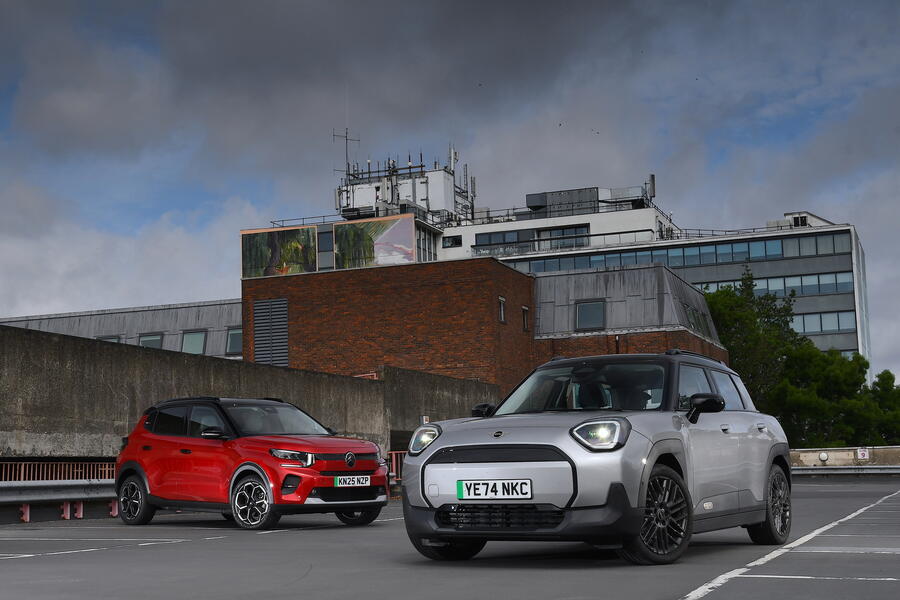
Practicality is much of a muchness between them. The French car’s boot is slightly bigger and I, as a slightly below average height man, wouldn’t like to sit in the rear seats of either for too long.
Comfort is key in this class, so I would happily take the Citroën’s leisurely pace in exchange for a more leisurely, less bone-jarring and happier ride around town.
Like-for-like comparisons paint the red Citroën at about £5000 more than the silver Mini. Out of context, that’s a huge sum of money, for sure – but if you’re shopping around and not too fussy about the options, the Aceman works out at about £50-£100 more per month on finance.
This figure really stood out to me as I inserted the key into the Citroën’s ignition barrel and twisted it. This feels absolutely bizarre in an EV: your hand is expecting a bit of feedback from a small set of controlled explosions that never come.
The Citroën’s instrument cluster above the steering wheel works really well and looks much more premium than the flimsy head-up display in the Mini. But nearly everywhere else the look and feel of the Aceman bests that of the Citroën.
The seats, infotainment, dashboard all just ace (ahem) that perceived quality thing. It feels well put together. Unique, even. Well, unique to the Mini brand, but you know what I mean.
By contrast, the Citroën largely just feels like yet another Stellantis product. Sure, I think the Aceman’s ride is rotten and I still can’t get on with the circular infotainment touchscreen.
But for me it’s easily worth another £50 per month. And things are set to get trickier for the ë-C3 as the new Fiat Grande Panda Electric arrives – the same mechanicals but on a more recognisable model, and one already well received.
Update 4
What makes a Mini a Mini? It’s a tough philosophical question (at least within our motoring world) and one that is hard to answer.
A lot of people have a very fixed definition – a definition that involves words such as ‘go-kart’ and ‘petrol’, neither of which apply to my Mini Aceman. I find it hard to subscribe to a definitive idea of what a Mini is, because Mini’s roots, while old and fortified by the Issigonis car that was largely similar and recognisable throughout its 41-year history, are actually quite varied.
I mean, the first ‘Mini’ famously made in 1959 wasn’t even a Mini: it was a Morris Mini-Minor. Or was it an Austin Seven? The two were basically the same, except for badging and grille, with the Austin built in Longbridge and the Morris built in Cowley.
Since BMW revived Mini in 2001, the hatchback has been the core model, but the rest of the line-up has often been really weird.
The Paceman was an SUV-coupé that stole sales from the Countryman; the Coupé’s roof was an out-there design inspired by a backwards baseball cap; and the original Clubman estate had a single rear passenger door, on the right-hand side of the car, which meant kids in the UK were forced out into traffic.
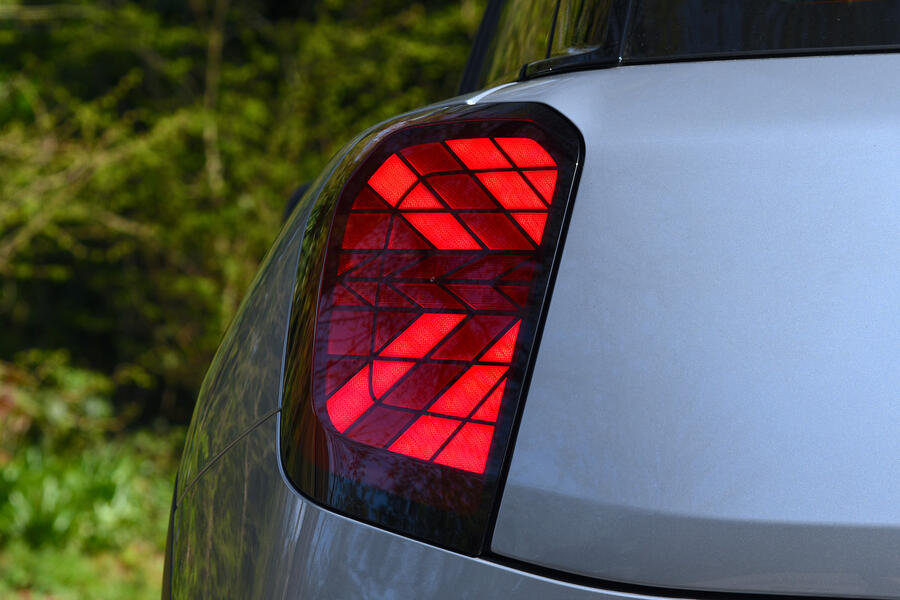
Minis are the Swinging Sixties, rallying, Cool-Britannia cars of the 2000s, but beyond all else they are weird. And using that logic, I can give the Aceman my blessing as a fully fledged Mini. It’s a short-ish, tall car with a small battery but, weirdly, is better suited to the motorway than the city, because of its brittle suspension.
I could write a thesis on the circular touchscreen: there’s a reason why TVs aren’t round. And you can spec Union Jack tail-lights, despite it being made in China. Go Kart mode turns everything up, including the noises.
There’s something of an uncanny valley to them, not only because of the futuristic soundscapes, but also because of what a good job they do aligning with the acceleration and deceleration.
The on/off switch is more of an unintuitive toggle. But most of all, the Aceman is much more fun to drive than it needs to be. I can even get a bit of wheelspin out of it. I don’t, but I like the idea that I can. Because, after all, it is a Mini.
Final updateÂ
It’s quite hard to define exactly who this Aceman is aimed at. The advertising features young urbanistas with coffee cups and Labubu dolls charging up in bright colourful cityscapes.
Certainly its range (190-mile WLTP, 150-ish real-world) and size (only a bit wider than a Renault Clio) peg it as a city car, but many young twenty-somethings who live in cities would be put off by the circa-£300 per month cost, given that rent for a one-bed in London is £1000 per month while a Lime bike is sub-£4 for a 30-minute ride.
So it’s not really aimed at people in their twenties; the Aceman’s target market is older people. People who live in suburbia. I’m kind of between these two bookends, being in my thirties and living in London’s Zone 3.
So perhaps that made me ideally qualified to test this car. Range and charging are the biggest questions when it comes to most electric cars. A WLTP range of 190 miles was never going to be 190 miles in real life. But 150 miles of mixed driving is on the cards if it’s not winter. If it is winter? More like 130 miles.
Around town and with the regen dialled up it gets close to 5.0 miles per kWh, which is good going. But at motorway speeds, and with the air-con on, this inevitably falls, and hard.
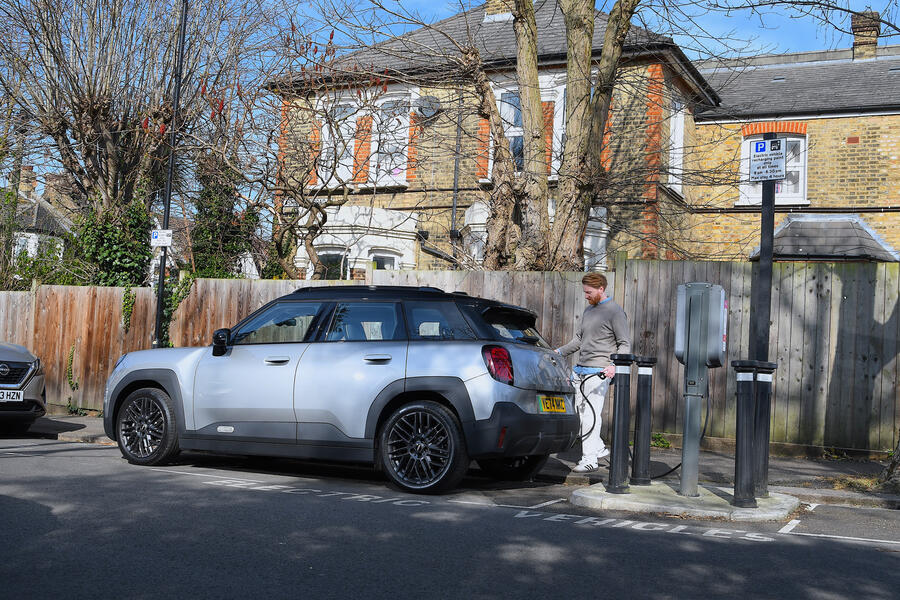
No, 150 miles doesn’t sound a lot, but this car has a small battery, remember, so it’s theoretically quicker to charge. Or it should be. My house is on a terraced street and doesn’t have a charger. There’s a set of 22kW zappers a few streets away, but the Mini doesn’t charge at 22kW: it only charges at 11kW (AC), which is annoying.
Overall maximum speed is 70kW (DC). Which is also eye-rollingly slow, when so many service stations are now capable of pulling in 350kW. At one Applegreen set it did actually peak at 75kW, though, which is to be commended.
The driving experience was also frustrating. The steering is really good for something of this ilk: heavy and direct but natural. It feels like it was developed to be this way from the start, whereas some EVs, such as Teslas, feel like everything was engineered, and then the software apprentice was asked to make it feel ‘sporty’.
The Aceman’s low-speed ride is just too jittery, though. Too firm. Too busy. It makes a huge deal out of every flaw in the road. And around me there are many. At motorway speeds it smooths out, settles and becomes a really solid cruiser. But just not for that long, or that far, because of that drastic drain on the battery.

It’s really not slow, though. A sub 8.8sec 0-62mph time and 213lb ft of instant torque is enough for any situation I could think of. The Aceman is even a bit of a bargain, weirdly. This realisation came after spending a day behind the wheel of a colleague’s Citroën ë-C3, which is similar in size and range but feels like an inferior product when it comes to the interior.
Every time I got in the Aceman afterwards, it made me appreciate what a clever and well-thought-out thing it is. The seating position is excellent: it’s upright and has ‘captain chair’-style armrests. But it isn’t all that high, and there’s enough adjustment if you like to sit low down.
I did, though, wish for physical heating controls, and it took me several attempts just to sign up to the Mini app. The reason we ran the Aceman was to find out whether small battery EVs are viable for daily use.
A few years ago the answer would have been no. But the charging infrastructure is now so much better than it was, so for me, living in the south-east of England, with no kids and no 100-mile commute, the Mini did work.
Charging is easy and a lot of my driving is short and urban, which is where the Aceman’s efficiency excels. Would I recommend the Aceman? It’s a likeable thing. But probably not.
Ultimately, the ride isn’t as good as it should be, and the range only just covers my needs. I gave this E model two and a half stars in its original review, and after a few months in one I stand by that.
Its interior and at times the way it drives make a strong impression, so if you bought one and enjoyed it, I would applaud your ability to look past its flaws and appreciate the charming bits. It’s just that I can’t.
Mini Aceman E Classic specification
Prices: List price new £28,905 List price now £28,905 Price as tested £31,455 Options: Level 1 pack (adaptive LED headlights, keyless entry, auto-dimming wing mirrors, auto-dimming rear-view mirror, heated front seat, high-beam assistance, head-up display, wireless phone charging) £2000, 18in Night Flash grey alloy wheels £550
Fuel consumption and range: Claimed range 190 miles Battery size 42.5/38.5mpkWh Test average 3.9mpkWh Test best 4.9mpkWh Test worst 2.7mpkWh Real-world range 150 miles
Tech highlights: 0-62mph 7.9sec Top speed 99mph Engine Permanent magnet synchronous motor Max power 181bhp Max torque 213lb ft Transmission 1-spd reduction gear, FWD Boot capacity 300 litres Wheels 7.5Jx18in Tyres 225/45 R18, Hankook Ventus Prime Kerb weight 1720kg
Service and running costs: Contract hire rate £291.82 CO2 0g/km Service costs None Other costs None Fuel costs £101 Running costs inc fuel £101 Cost per mile 9 pence Faults None
